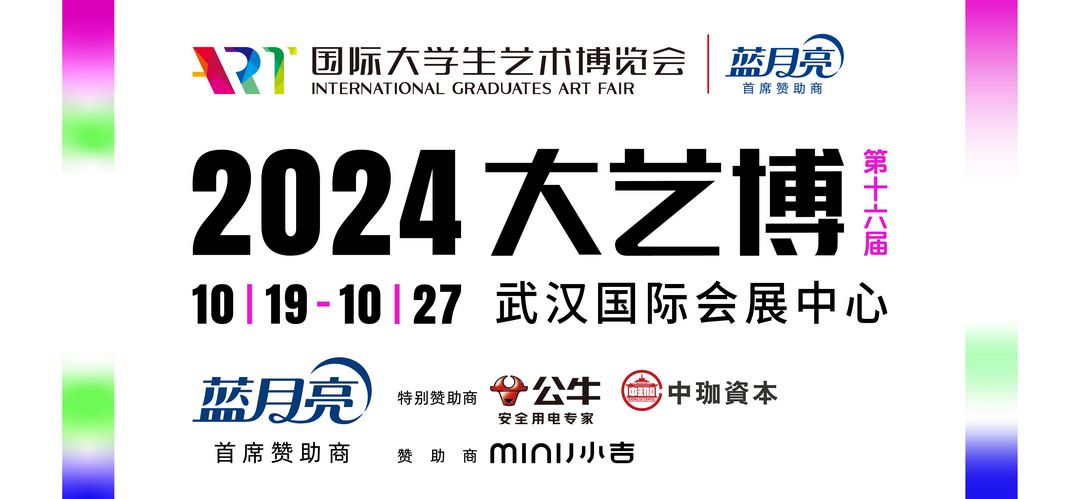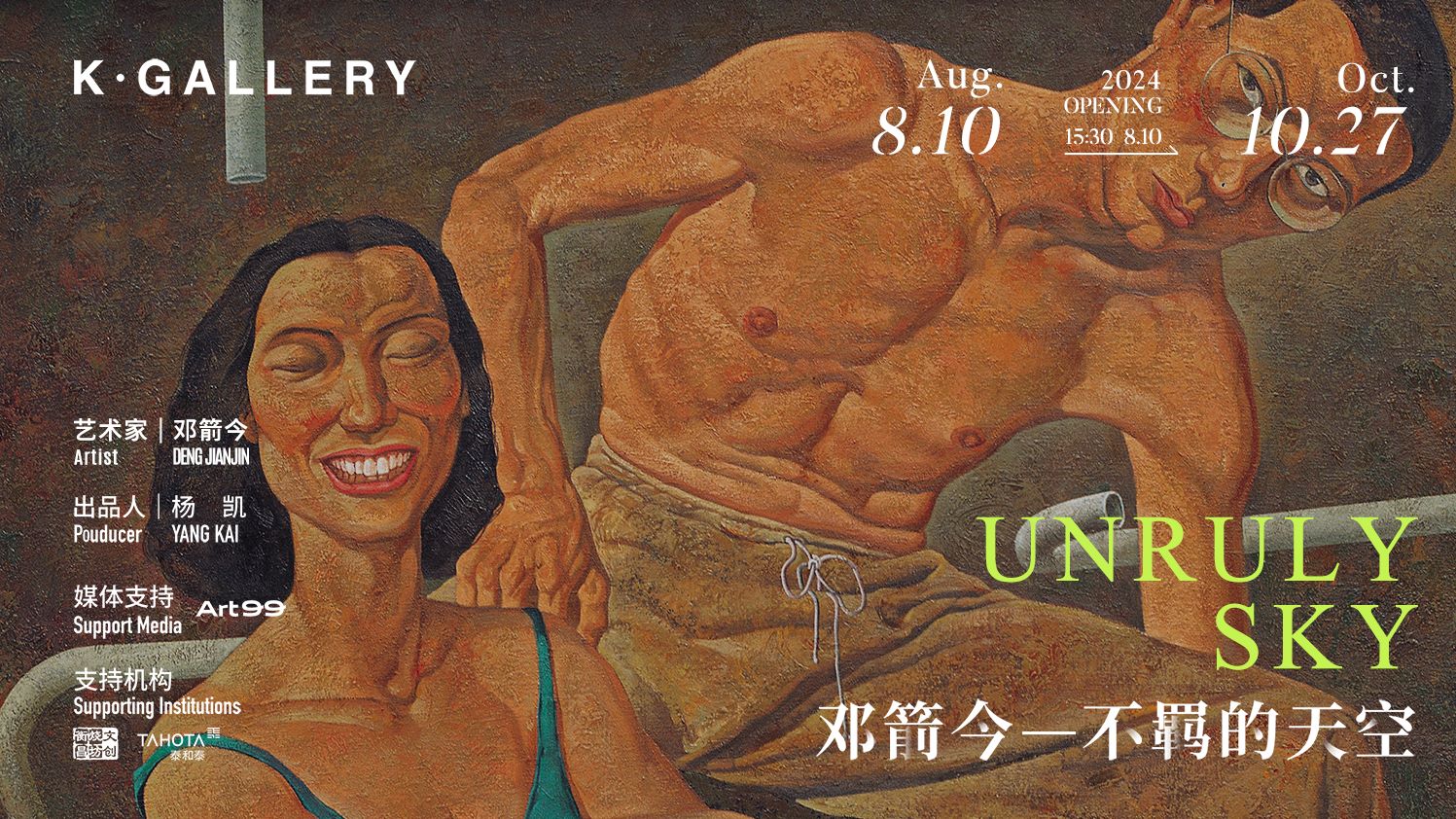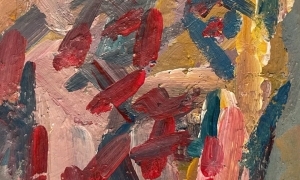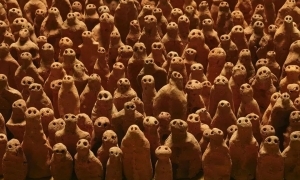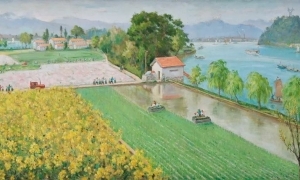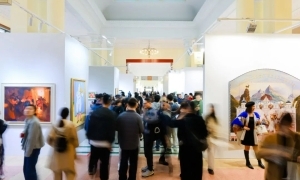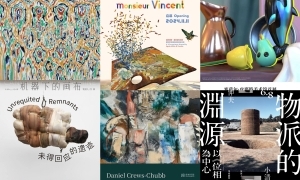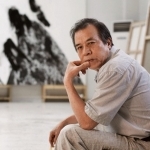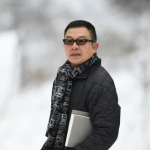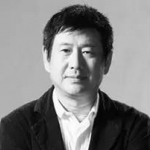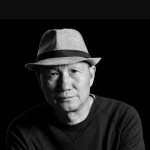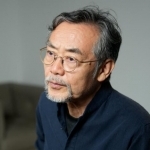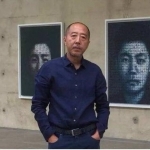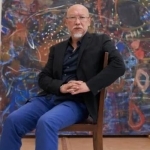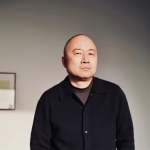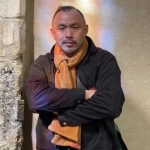从背影说起:再现自我的影像
最初看见徐勤,是在朋友的电脑桌前。
网络和即插即用的移动硬盘,可能都是这个时代最伟大的发明,便捷到我们一旦学会使用,就仿佛再也离不开。即便像我这样的电脑盲人,与他人交流时也总避免不了弄上几下。可病毒发展得一样迅速且生猛,在我们习惯拥抱网络和便携式移动设备的同时,借着这两个无所不在的通道侵入。和现实生活中的病毒没有什么两样,电脑虽然没有什么痛楚,却也在不知不觉中陷入瘫痪。系统的崩溃总让我们惊惶失措,因为这里面装着的和可能带来的东西,好像比我们与生俱来的那个脑子还要多得多。
灯光下背对我的艺术家陷在一片阴影中,嘴里叼着一根烟,吞云吐雾、似笑非笑、赤裸上身、假不正经、目不转睛……十个手指头飞快地在键盘上敲出劈劈啪啪的声响,看上去比那台中了病毒的电脑,还要诡异和令人费解。有点痞子的模样。
这个背影,最后变成了一件作品——就在徐勤自己的Video里。短片很短,刚好一分钟。前25秒,他就像我最初看见他的那个样子,背对观众坐在电脑前。不过这次他不是帮我的朋友维修中了病毒的电脑,而是聚精会神地投入电子游戏。他面前的电脑屏幕光线惨白,里面的格斗人物不时发出阵阵怪叫。一秒钟的黑暗之后,画面变得安静无声。唯一不变的还是那个背影,只是无声的窒息让我们更能感受到玩游戏者的投入。他身体僵硬,想必目光凝滞、头脑空空。一道道电波干扰似的波纹在屏幕上滚动,镜头渐渐拉远,此刻我们发现,原本坐在电脑前玩游戏的艺术家,变成了电脑屏幕上的画面,格斗的人物不见了,由艺术家的那个背影取而代之。电脑前面一片狼藉,成为可乐瓶、啤酒瓶、矿泉水瓶、方便饭盒和塑料袋的垃圾场……这件作品就是《超级玩家》,2006年参加了荷兰阿姆斯特丹的一分钟影像展。
后来据我的朋友说,他修电脑一级棒。再后来,我们办公室的电脑一坏,为了帮公家节约钱,我就会请他来上演一场“超级玩家”;再再后来,艺术家的时间变得越来越宝贵,我开始思考,是不是应该多结交点另外的“玩家”……不过最初的印象总是很难磨灭,那个痞子式的背影让我印象深刻。说来很巧,10年前,网络小说刚刚盛行,一个叫化名“痞子蔡”的台湾水利专业研究生,写了一部《第一次亲密接触》,一度刮起了网络交友的龙卷风。大家一起在电脑面前沦陷。这让我觉得,《超级玩家》不单是徐勤的自传故事,也不仅仅是一代年轻人的生活状态,主妇或者白领、学生或者股民……今天,我们的生活或多或少地变得与这个小小的屏幕相关。就像《超级玩家》的结尾,所有的观众都变成了那个最初在屏幕前凝视的背影。而下一秒,再现的或许不仅仅是艺术家,还有我们自己。
徐勤后来还与其他艺术家合作了许多短小的影像作品,例如《Fly》,讲述如何用一只苍蝇的眼睛来看世界;《39 seconds》,一个男子坠楼的飞翔故事;《知会我》,一个杂糅了独白、访谈、资料片剪辑和拼接的视听报告……风格不甚统一,但都不如这一个短片让我有共鸣。倒不是说《超级玩家》拍得有多好,而在于它就是我视觉经验的再现,像我最初看到艺术家的场景回放一样。我相信这种真实,哪怕它往往过于普通,但仍然有触动的力量。
Up Up Down: 玩出来的装置
鸡头人与黄桷星球:连环相扣的绘画
我的童年时代,日本漫画还没有来得及飘洋过海。于是,在儿时记忆里称王称霸的,除了电视而外,应该要算“小人书”,学名叫做“连环画”。那些看似独立的画面,其实环环相扣,密切相连,有着自己的编码和节奏,不需要过多的衔接或旁白。
徐勤的绘画仿佛就是这种记忆的放大。
于是,对肌理、笔触、光晕、结构或者空间……这些绘画技艺的追求,让渡给了故事和情节。画面中讲述的,很多是艺术家科幻式的臆想,但同时纠结着我们熟悉的现实。
《黄桷星球》是故事的发生地,也是艺术家最近一系列创作的开端。接下来的很多剧情,都在这里一幕幕上演。之所以选择这个场景,或许并没有什么特别的意义,不过就是因为它是徐勤和他的大多数朋友,每天吃喝玩乐拉撒睡都要面对的地方。《黄桷星球》的主人翁顶着一顶鸡头模样的帽子,他手里端着一碗汤面,大拇指不客气地抠到碗里去——这是在黄桷坪街头吃饭最常见的情景:大多数路边摊上菜的时候,都常把手指挖进去,我从来不敢看他们黑色的指甲——所幸艺术家并没有刻意强调这个细节。所以,散落在这颗星球上的,是现实生活中黄桷坪街道上随处可见的风景。例如,这里的地标性建筑——电厂,那两个红白相间的大烟囱总是高高矗立;坦克,它们会在偶尔晴朗的日子轰隆隆的碾过黄桷坪,而原来停放坦克的地方,现在被四川美术学院改建成了坦克库·重庆当代艺术中心,即将成为当代艺术的新地标;巴士,从黄桷坪开往沃尔玛,那是距离这里最近的大型超市,五楼设有电影院,每逢周二票价减半;还有艺术家的朋友,他坐在他自己曾经画过的“三轮摩托车”里——艺术家朋友为自己的这张画取名叫《法拉利》;机器人,它是重庆又一道活动风景——俗称“棒棒”的变体。这本是以劳力换取报酬的一个人群。不过现在,黄桷坪的“棒棒”有很多也变成了兼职的艺术家……
和著名电影《星球大战》以及任何一个关于星际空间探索的故事一样,这颗星球总会因主人翁的到来,而发生惊天动地的变化。于是,《失落的行星》向我们呈现了变化发生的第一幕:画面上的主人翁依然带着鸡头面具,不过这一次我们看不到他的表情,冷硬的头盔让眼角那一滴眼泪看来略显诡秘。头顶是霹雳闪电,身后是翻滚浪花,地标烟囱半倾在水中;到沃尔玛的巴士变成了划桨小艇;艺术家朋友开着水上三轮摩托;而棒棒机器人正挥臂呼救……可主人翁的手里握着的花洒还在滴水,我们猜不透,这场浩劫他是始作俑者,还是前来力挽狂澜的英雄?
《辐射星球》是灾难的延续:地标电厂又一次倒塌,引发了地裂,岩浆和怪物从地底一冒而起;棒棒机器人开始造反;沃尔玛巴士被迫改变了行驶方向;艺术家朋友不得不放弃他的坐骑,乔装潜逃……主人翁愁眉不展,鸡头帽在逆光的处理下变得凝重……
悲剧不会反复上演,于是《黄桷方舟》出现了,和传说中的诺亚一样,肩负起带领星球生物逃生的使命。不同的是,这次方舟不是在大海中航行,而是一场星际旅行;鸡头飞行器上主人翁,手里握着遥控板,这令逃亡看上去不过像是履行某个已经预设好的程序而已。
仿佛经历劫难之后,我们总需要找寻精神的皈依,于是,取西经的经典脚本也派上了用场——《流沙河》描绘了现代版的唐僧、悟空、八戒和沙僧,它们在方舟着陆后来到黄沙遍地的黄桷星球,地标烟囱和棒棒机器人就是最好的坐标。值得一提的是,当画面上的整个地球化为沙漠,世界上唯一有液体的地方,竟然是著名艺术家达敏·赫斯特(Damien Hirst)的装置《泡在甲醛中的鲨鱼》。这个待遇,足以让所有的艺术家都沾沾自喜。
宏大叙事和史诗篇章,最终让位给了微妙的感情。创作《铁达泥巴号》的时候,徐勤正陷在莫名的悸动中。于是,画面的主人翁站在黄澄澄的飞船上,望着灿烂又空洞的满天星斗,不知道是在告别还是在迎接他面前那位悬浮在半空中的粉衣朋友。如果《铁达尼号》讲述的是浪漫爱情,那么和黄金同属一个色系的铁达“泥巴号”,咀嚼起来有一点伤感的味道。
……故事可以一直说下去,主人翁在黄桷坪无止尽的游荡:喝奶茶、吃火锅……画面就是这样荒诞而真实。我始终可以在徐勤的绘画中,看到周围每天每时每刻正在发生的一幕幕,而那些熟悉的人、事、物,变换着角色,不断出现在艺术家的一作品里。仿佛有一根看不见的线索,隐匿在那些迥异的情节背后——这个时候,我总遗憾自己不太会说故事,不然这些画面会和英国作家柯南道尔笔下的《福尔摩斯》一样,连成一道正在破解中的谜题。而我时常有这样的错觉:画面中的主人翁——那个总是隐匿在鸡头面具下的神秘人,就是艺术家笔下的另一个自己。在故事里,在他陷在这个现实和虚构相重叠的艺术时空中,他狂躁、忧郁、兴奋、健忘、敏感;他不知所措、难以自己、患得患失、异想天开、无拘无束;他带着青春的冲动,怀有成长的烦恼,夹杂情感的憧憬,具有破坏的欲望,充满英群的幻想……
也许,“连环画”早在电视和网络的冲击下,淡出我们的视野;同时也很难和当代艺术的前卫、先锋扯上半点关系。从这一点上看,徐勤的绘画似乎缺少优势。但是,视觉是一个有记忆的东西,当这部放大了的“连环画”呈现在我们眼前,儿时的视觉经验和本能的读图习惯就会被自然而然的勾引起来。这令观看和解读的过程变得轻松愉悦。
THE BACK: Reveal the Image of yourself<0}
<}0{>The very first time when I saw Xu Qin, he’s sitting right in front of a friend’s computer.<0}
<}0{>Internet and plug-in mobile Hard Drive, probably the most amazing and convenient inventions of this century, are simply impossible for us to live without them once we learn how to use. Even for a computer idiot like me, it's still inevitable to give a few clicks to chat with others. On the other hand, virus has been spreading everywhere with it's incredibly fast pace and entry, invading in our lives through the above two most common used channels-Internet and portable mobile device. Not much different from the virus in our real life, computer never feels pain but still breaks down without any sign. The break-down of the computer system always cause panic as what the system contains and might bring are way more than what our brain could contains. <0}.
Sitting in the shadow of the light with his back against me, this topless artist with a cigarette as well as a weird smile on this face is puffing out loads of smoke while staring at the monitor, making lots of noises with each and every fingers clicking on the keyboard as quick as he can. His behavior is way odder and more riddle than this infected computer itself, just like a riffraff with plenty of time to do nothing and also has nothing to lose.
The image of his back ended up appearing in Xu Qin's own work, a one-minute short video clip. In the first 25 seconds, he's still sitting in front of the computer with his back against the audiences as I saw first saw him. Instead of trying to fix my friend's computer which has been infected by virus, this time he's just concentrating on playing computer games. The monitor reflects pale light in front of him and from time to time some weird sounds can be heard from the fighting game he’s playing. After a second blackout, those images disappeared all of a sudden. The only thing remains is the image of a back, which leaves all of us a breath holding silence and a feeling how devoted this player is. He sits still, presumably looking at the monitor with glazy stare and nothing in mind. Electronic waves start to roll down on the screen as they are disturbing the signal, while the camera zooms out, we suddenly find the artist who was playing games turned into the image on the screen. Those characters in that fighting game vanishes, instead, the back of the artist turns in. There’s such a mess in front of the computer with coke bottles, plastic bottles, paper boxes and plastic bags scattered everywhere…... This work is called “Super Player”, which has attended the One-minute Video Exhibition in Amsterdam, Holland in 2006.
Later, I heard from my friend that Xu Qin is a genius in fixing problems with computer. Since then, I always ask him to play once again the "Super Player” whenever any of our computers in the office break down, in a good manner of being cost-efficient for us. After a while, the artist seemed to be really busy and I started to come across meeting some other "players"........ however, the first impression is always unforgettable and this typical back of a riffraff still impress me till now. 10 years ago when online writing just started to be popular, a book named “The first close relationship” written by a postgraduate student named “Riffraff Cai" majored in water resource in Taiwan has swept through the net and turned on a huge wave of online dating. Everyone started to fall in internet. This made me realized that "Super Player" is not just telling Xu Qin's own story or representing the life style of this young generation, including housewives, white collars, students, stockholders, etc. Today, our life become more or less relevant to and has been connected with this little screen. As the ending of "Super Player" turns each and every audience the back image which appear in the beginning of this video, but what will appear in the next second, probably even ourselves other than the artist himself.
Xu Qin also has worked with some other artists on many short films, “Fly”, for instance, which portrays a world from a fly's perspective; or “39 Seconds”, a story about a guy who jumped off the building and flying; or even “Perceive Me”, a special report mixing script, interview and video clips. The style varies, yet none of them has brought me to this emotional moment as this one did. The point is not how well "Super Player" is done, it is a reimage of my visual perception, resembles replay of the scene when I first saw the artist. I believe in this authentic and real feeling it brings out as they are usually too plain and close to the real life but still very touching.
UP UP Down: A device to play
Man with rooster head and Huang Jue Planet: Serial Painting
My childhood was too early to experience the massive stream of Japanese Comic, instead, besides TV, the most popular in my time was supposed to be “Strip cartoon”, also named as “strip cartoon series”. These scattered images are always connected with one and another with their own codes and rhythm, no intentional content or script needed.
Xu Qin's drawing seems to be the zoom-in of this memory.
To this effect, pursue of all the skillful techniques including texture, strokes, Brightness, structure or space has compromised to the story itself. The images mostly narrate artistic fictions and imaginations blended in the real world we are familiar with in the meanwhile.
《Huang Jue Planet》 is where the story taken place, as well as the very first stage of the artist's latest series. Most of the scenes followed were performed here one by one. The reason why this scene has been chosen might not be anything special as it’s at where Xu Qin and most of his friends spend everyday. The Main character of 《Huang Jue Planet》wears a hat resembles rooster head, holding a bowl of noodles with his thumb abruptly sticking into the soup. This is a common scene while dining out on Huang Jue Street where most of the venders serve their food together with their fingers showing you black nails containing all the possible dirt which is always too frightening for me to see. Fortunately the artist didn't really pay much attention to this trivial. Everything scattered in this planet are views and scenes we can see on this street in real. The landmark construction-the power plant, for instance, with two giant chimneys with strips in red and white standing above the clouds; the tanks, marching through the square in some of those sunny days, while where they used to be parked has been rebuilt by Sichuan Fine Art Institute into Tank Loft · Chongqing Contemporary Arts Center, which will soon become the new landmark of contemporary arts; the buses, heading from Huang Jue Square to Wal-Mart, the closet large supermarket with cinema on the 5th floor, 50% discount every Tuesday; and the artist's friend sitting in his old work named "The Three Wheeler" - renamed later 《Ferrari》by himself; Also the robot, the transformation of another mobilizing scene in Chongqing called “Bang Bang" (hammal who serve as public transport for all types of cargo) who used to be a large group of people who survive by providing physical work and nowadays many of who has turned to be part-time artists at Huang Jue Square.
Just like the famous block-buster movie 《Star War》 and any other stories about outer space discovery, this planet always encounters unprecedented changes upon the main character's arrival. 《The Lost Planet》, reveals the first one for us: the main character still wears a rooster head mask veiling his facial expressions and, the cold and hard helmet turns the tiny drop of tear hanging on the corner of his eye even more weird and mysterious. Thunders and lightening up above, rolling waves behind, the chimneys stands inclined towards the water; the buses to Wal-Mart turns into little boats; the artist’s friend rides on a water motorcycle; the robots waves their hands and asks for help…….yet the rooster head man holds a showerhead which is still dropping, which leaves us wonder if he's the reason that all this sad episode should be blamed for or the hero who comes to save the world with his magnificence.
《FALLOUT Planet》is the following episode of this disaster: the power plant collapse causes earth cracking and lava and monsters come out from the ground; robots start to stir up some uprisings; bus to Wal-mart is forced to change its itinerary; the artist’s friend has to give up his ride and escape in disguise…… a frown comes up on the rooster head man and against the light this hat looks grave.......
Tragedy never happens again. Then 《Huang Jue Ark》arises with the same mission of leading all the lives escaping from this planet, resemble Noah in the Bible. Instead of sailing in the ocean, this time the ark has experienced a travel spree in the outer space; the main character driving a rooster-head spaceship with remote control holding in his hands, which turned out to be one of the steps in a program been completed other than an escape.
It seems that we always need some spiritual comfort after disaster like this, classic script from “A Journey to the West” has been adopted into the next episode - 《Liusha River》 portrays a modern version of the master Tang and his three apprentices taking the ark and landing on the Huang Jue planet where yellow sands are everywhere, notably the best directional signs as the landmark chimneys and the group of robots. When the entire earth turns into a desert, the only place with liquid surprisingly points to famous artist Damien Hirst's work –《 A shark soaked in Formaldehyde》. This idea must be creative flattering enough to make each and every artist proud of themselves.
Splendid narrating and epic chapters compromised to the subtle emotions by the end. When Xu Qin's working on 《Titan-earth》, he was in an indescribable emotional moment, so the final episode ends with the main character standing on the yellow spaceship while staring at the stars twinkling in the empty sky. The end leaves us wonder if he was trying to say goodbye to or rather welcoming his pink-dressed friend floating in the air right in front of him. If “Titanic" is a story about sweet romance and love, 《Titan-earth》, with a gold-like color, has brought out more blue and gray feeling.
……The story still goes on and on, as the main character wonders around at Huang Jue Square, drinking milk tea, eating hotpot…… all the images seem to be so absurd and real. In Xu Qin’s paintings, I can always find what are happening around me every and each moment of the day and, watching those people, things and objects that we are familiar with changing their roles in different works of this artist. There seems to be an invisible string hiding behind all these differed stories and this is absolutely the awkward moment that I feel my imperfect narrating skills is not able to connect all the clues to one pending puzzle, just like the “Sherlock Holmes” by English author A. Conan Doyle. At times I also feel confused that the main character on those images, this mysterious man who always hide behind the rooster head mask, is just another me under the artist’s portray. In the story, when he was stuck in the art world which combines reality with fictions, he became maniac, upset, thrilled, forgetful and sensitive; he was confused, fussy, fanciful and unstrained; obsessed by the fact of growing up with anticipation for emotions, desires, and imaginations, he was active and impulsive, like any other youth of this century.
Perhaps, “strip cartoon" has already faded out from our sight with the heavy strike of TV and Internet, and also turned to be less relevant to the most updated and edgy contemporary arts. Xu Qin's paintings seem to be less advantageous, however, visual perception is memorable. When the bigger version of this “ strip cartoon” is represented in front of all of us, our visual emotional memories and image-reading nature will be automatically activated, which turns either watching or reading to be a very relaxing and pleasant experience.
【编辑:小红】



